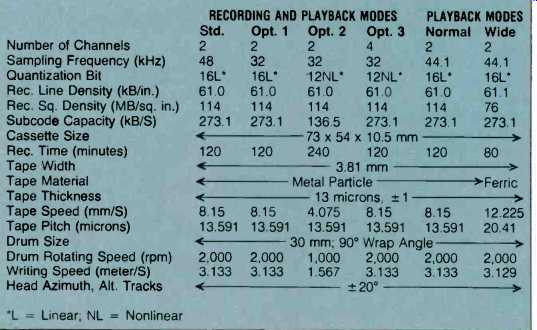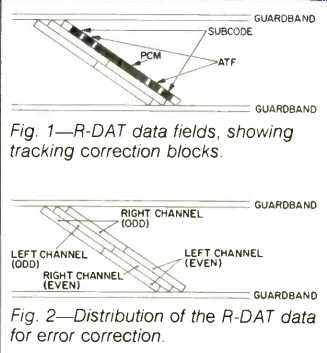
UNSPRINTABLE OPTIONS
The ink had barely dried on my critical examination of DAT (in the February and March issues) when the letters started arriving. Of course, every in-house journalist knows that crank mail typically far out weighs fan mail, but I was still surprised at the growing imbalance of opinion. Letters of encouragement from analog fans, desperate to put the hex on the next digital technology? No. Irate letters from digital supporters, displeased at criticism of their conquering hero? Nope. The reactionary correspondence came in business envelopes, on letterhead, from Japanese audio companies.
When big companies take issue with an individual, some very tangential things can be said, especially when the companies involved are bona fide, aboveboard, maximum-integrity outfits which fully understand the power of the audio press. An exceedingly polite message is conveyed; no mention of a disagreement is made. Rather, points are argued with copious amounts of information. The tacit message is: "As you can see, at great cost we have figured out the technology; it's great, the public will agree, and we shall re coup our investment." Backed by the weight of technical evidence, that's a hard argument to counter. All the numbers and diagrams certainly inspire confidence, as well as some expectation. And it is clearly high technology, hence it must be desirable. As I sifted through the pages of documentation, I wondered whether I had been foolish in shooting off my mouth against DAT. Were my objections to the soon-to-be format founded on defensible hypotheses, or was it only a case of intolerance based on lack of information and awareness? I decided to take a closer look at the technology of the DAT system. Coincidently, a recent Electronic Industries Association of Japan (EIAJ) committee meeting has resulted in new guidelines for the design of the system, affording us a greater understanding of things to come. This EIAJ committee was formed in 1983 to guide development of DAT, and now consists of 81 manufacturers (60 of them Japanese). With in the committee, there are R-DAT and S-DAT subcommittees. It firmly controls the destiny of DAT.
At this time, S-DAT appears to be on the back burner, due to technical obstacles such as head technology and tape formulation. On the other hand, R-DAT is forging ahead, borrowing from video head and videotape technologies which already offer wide re cording bandwidths. Because R-DAT can adapt existing technology, it appears to have the shortest road to commercial realization and thus the best prospects for near-term success.
One of the benefits of digital technology is the flexibility of design parameters; the EIAJ committee has used this flexibility to expand DAT's capabilities--or abused it to the point of confusion, depending on your point of view. Table I shows the format specifications for R-DAT. There are no fewer than four record/playback modes and two play back-only modes. Every R-DAT ma chine will have at least the Standard record/playback mode and both play back-only modes (called Normal and Wide). The other three modes are options for specific applications.
The Standard record/playback mode offers 16-bit quantization and a 48-kHz sampling rate. Full digital in puts and outputs will permit digital re cording and playback of data; how ever, that capability is crippled by the committee's choice of sampling rate.
By design, 48 kHz is incompatible with the Compact Disc's 44.1-kHz sampling rate. Thus, you will not be able to digitally transfer CD material to tape even with a CD player that has digital out puts; intermediate conversion to analog will be required.
Though you won't be able to record digitally at the 44.1-kHz sampling rate, you will be able to play back tapes made at that rate-prerecorded tapes made by the record companies from the same masters they use for CDs. In addition, every recorder will have a feature which prevents operation if any digital source has been copy-guarded. While all of this puts the whammy on piracy, it also has the effect of creating a digital recorder with little or nothing digital to record. I suggest that the R-DAT logo depict a sprinter who has just shot himself in the foot.

Table I--Specifications for R-DAT operating system
The only record/playback modes with potential digital source material to record are the optional modes, which all use 32-kHz sampling rates. Option 1 provides two hours of recording time and Option 2 provides four hours. Option 3 allows two hours of four-channel recording and playback. What kind of digital source material is available for full digital recordings? There is direct-broadcast satellite material, beamed at 32 kHz, in Japan and parts of Europe-but it's not available in the U.S. I think the sprinter actually shot himself in both feet.
Okay, okay, you've just sunk $2,000 into an R-DAT recorder. You'll never use it for digital recording because you don't live in Japan or Europe. You can't make digital-to-digital copies of your Compact Discs (unless someone markets a black-box sampling-frequency converter, but on the other hand, why record a CD to tape anyway?) and you can't make digital-to-digital copies of prerecorded R-DAT tapes. And how often will you use it for live microphone recordings of, for example, your mother-in-law singing opera arias? Well, what will you use your R-DAT for? You can do what all analog cassette recorders already do-record from analog sources or from digital sources converted to analog. Or you can play back prerecorded digital tapes. Tapes for the Normal playback mode will be mass-recorded in real time; as with the record/playback modes, metal-particle tape will be used. Tapes made for the Wide play back mode can be prerecorded at a higher speed using the same sort of "contact print" techniques that are used to duplicate videotapes: A blank tape is fast forwarded (200 times nor mal speed) in contact with a master tape; a focused magnetic field at the point of contact causes the blank tape to assume the magnetic characteristics of the master.

Fig. 1--R-DAT data fields, showing tracking correction blocks.
Fig. 2--Distribution of the R-DAT data for error correction.
Because the signal level resulting from contact duplication is significantly lower than that of normal-speed dubbing, the Wide mode requires a wider track than the other formats to compensate for the decrease in output level. This is accomplished by running the tape 50% faster. Playing time is reduced to 80 minutes; however, since the recording square density is lower, regular ferric oxide tape may be used instead of metal tape.
All R-DAT modes use a common head and tracking system. The rotating drum has two heads 180° apart, with a tape wrap of only 90°. Because of the low wrap, tracking stability is said to be better than M-wrap and U-wrap video systems. This should facilitate design of portable and car players. To help ensure accurate tracking, a dedicated tracking correction system is employed. As shown in Fig. 1, part of each data track contains correction data (labeled ATF). As each track is read, the head overscans the track width to read a small part of the adjacent tracks. Then, the intensity of the ATF data is compared to that on adjacent tracks; a difference causes the tracking correction system to adjust the head accordingly.
Other data blocks are used for sub-code. As on the Compact Disc, this data is used for tape time, indexing, music selection, etc. The audio is contained in 196 blocks of PCM data. As with any video-based system, time compression must be used to divide the continuous signal into fields, with enough time left between the fields to accommodate the recorder's head-switches. The fields are rejoined in playback.
Each track is split into halves, for left and right channels, as shown in Fig. 2. To facilitate error correction, data for each channel is additionally split into even and odd data blocks, one for each head. If one head reads bad data (because of dirt on the tape or a tape defect), the other head's received data can be used to interpolate the missing information. All of the data is encoded with the Reed-Solomon error-correction code, as on CDs.
Technically, the R-DAT has apparently arrived. Pending critical first hand listening tests, I can only speculate that it will sound better than analog cassette recorders. In the same way that the Compact Disc conquered the analog disc, digital audio tape might conquer the analog cassette. Like the CD, it should provide higher fidelity, longer playing time, and conveniences such as programmability and indexing. It will also further open the door to future-generation audio systems in which digital outputs from sources such as the CD and DAT are digitally processed and amplified.
But I'm still not a believer. The purposely incompatible sampling rates largely negate the supreme advantage of DAT-direct digital recording of digital sources such as CD and DAT. Why design lameness into a product? That's a technological tragedy.
(adapted from Audio magazine, Jun. 1986)
Also see:
Dr. Thomas Stockham on the Future of Digital Recording (Feb. 1980)
= = = =